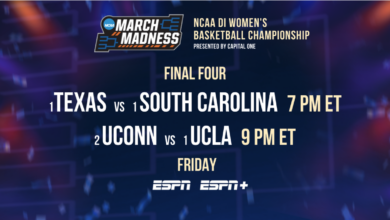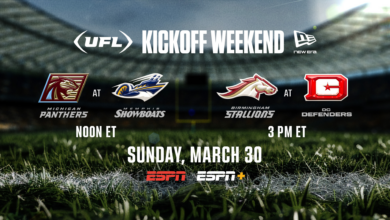New In The 30 for 30 Playbook: Why ‘Deep Fake’ Technology Is Used In ‘Al Davis Vs. The NFL’
ESPN Films EP Erin Leyden explains how the storytelling device allows legendary rivals Al Davis and Pete Rozelle "to essentially narrate their own story."
ESPN Films’ latest film in the 30 for 30 series, “Al Davis vs. The NFL,” premieres tonight (9 ET, ESPN) and will be available immediately following on ESPN+.

Directed by Ken Rodgers (“The Two Bills,” “Elway to Marino”), the documentary presents an intimate look inside one of the great rivalries in the history of the National Football League – between former Raiders owner Davis and former NFL commissioner Pete Rozelle. Their battle grew so intense that it changed the sport forever.
The film features never-before-seen footage of both men. It takes a fresh, alternative approach: allowing Pete and Al’s spirits to tell their own story by using new, innovative technology, commonly known as “deep fake,” and having them narrate their shared tale in first-person.
Front Row spoke with ESPN Films executive producer Erin Leyden about the technology and why it was used to tell this story.
You serve as executive producer on the project. What does your role entail?
When a project gets a greenlight to start production, I’m involved in developing and refining the creative for the film. In this case, that involved lots of discussion of how to best utilize the deep fake technology. I watch multiple cuts of the film throughout the edit process and give notes. I see my role as helping make sure the director achieves his or her vision for the film, and of course, making sure the film gets done on schedule. I should note that a producer on the Films team, in this case Kristen Lappas, does the heavy lifting of day-to-day producing and project management.
Beyond the actual production, I am also involved in figuring out best distribution plan as well as marketing, PR, and social strategy.
What is deep fake technology? Why was it used in the film?
Deep fake technology was used in the film to put the faces of Davis and Rozelle onto stand-in actors. Instead of having actors wear physical masks on set, digital masks were added in post-production. With both Davis and Rozelle deceased, the technology, paired with voice impersonators, allowed the two men to essentially narrate their own story.
I think in this particular film, it really served the story. I’m glad we took the risk in trying something new. We’ve always prided ourselves on every 30 for 30 film having its own look and feel. — ESPN Films EP Erin Layden on using “deep fake” technology
Why did you feel it was important to use the technology? What makes hearing the story directly from Rozelle and Davis so important in this case?
Hearing the words of Davis and Rozelle, meticulously researched and written by Ken Rodgers and his team at NFL Films, created a connection to the characters that I don’t think we would have gotten if Ken had gone a more traditional documentary route of using talking head interviews, especially considering so many of the people who witnessed their battles firsthand are also deceased. The combination of the archival footage and the scenes with Davis and Rozelle at the stadium had me feeling like I was really living in Davis and Rozelle’s world, despite the crux of the story taking place more than three decades ago.
Do you think ESPN Films will be utilizing the technology in future projects?
We leave it up to our filmmakers to decide how to best bring their visions to life. I think in this particular film, it really served the story. I’m glad we took the risk in trying something new. We’ve always prided ourselves on every 30 for 30 film having its own look and feel. So maybe it won’t be the deep fake technology specifically, but I’m keen to see what we can do down the road that continues to innovate in the documentary space.







